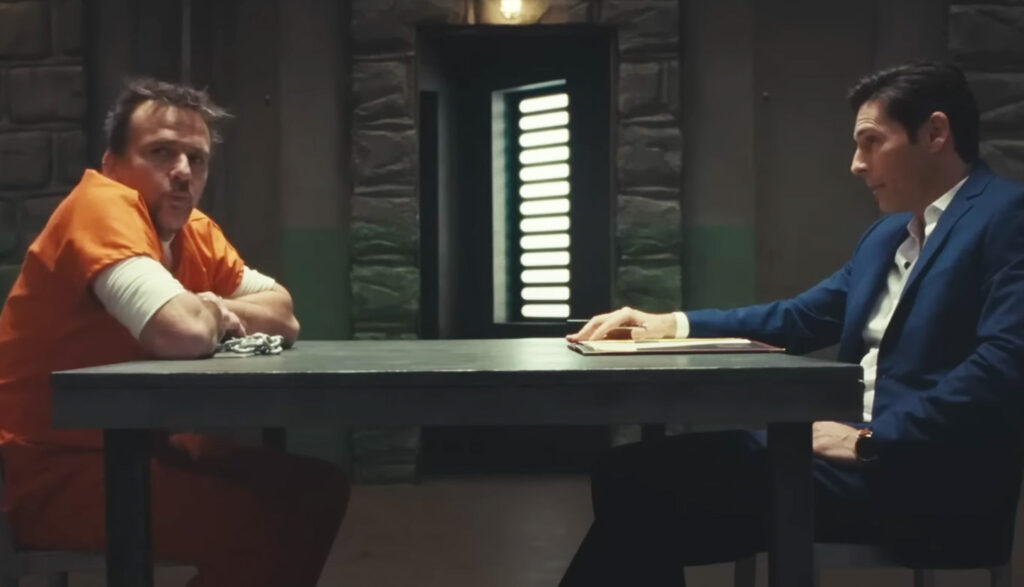
After 11 years on death row and many delays, serial killer Edward Wayne Brady is scheduled to be executed by electrocution in an Oklahoma prison. But before that justice can be meted out, a professional psychiatrist must certify that the convicted killer is, in fact, sane—a step that’s proving difficult to complete.
“Every time this guy Brady’s number comes up, something happens,” the prison’s warden, Tom Moss, tells Dr. James Martin, the doctor who’s just arrived to certify Brady’s sanity. Indeed, James’ own mentor, Dr. Alan Fischer, was supposed to have done it. But after meeting with Brady, Fischer took his own life.
The incarcerated killer is, Warden Moss warns James, a “master manipulator.” Then he adds, “Brady knows what’s coming. He’s playing the system. And if you allow him to, he’ll play you too.”
James is unperturbed. He’s a professional, after all. “Look, I get lied to all the time. Figuring out the truth behind the lie is what I get paid to do.”
But Dr. James Martin has never encountered anyone like Edward Wayne Brady. In fact, it’s not clear that the person James is speaking to is Edward at all.
“Death doesn’t scare me, James,” the convict tells James.
“And why is that?”
“Because I can’t die. You see James, I’m a demon. … [Edward is] merely my host body, which I inhabit.”
James, whom we soon learn is a staunch atheist, doesn’t buy Edward’s demonic possession story. But Edward—who tells James that his real name is Nefarious—is just as unperturbed as James was a few minutes before.
And, Nefarious says, he has a secret. A secret about James: “Before you leave here today, you will have committed three murders.”
“I don’t think so,” James says coolly.
“Has nothing to do with your thoughts, your wants, your yeses or your nos. It simply is. It’s a fact. It’ll happen because I say so.” And in the handful of hours that follow, Dr. James Martin might just discover whether Nefarious is who he insists he is.
There’s little here that can be characterized as positive in the way we normally talk about characters’ moral virtue or choices. James is, in a way, a sympathetic character, because he quickly begins to realize that whatever is going on with Edward/Nefarious, it’s unlike anything he’s ever encountered.
But James himself is not particularly noble or good. He’s good at his job, certainly. But as Nefarious points out, he’s self-serving and focused on his own needs and wants, unwilling to sacrifice anything for the sake of others. And, it seems, the demon’s clear-eyed understanding of James’ character is deadly accurate.
What we could characterize as positive, then, is this cautionary tale’s main message: The devil and his underlings are not to be underestimated in their ability to deceive and destroy—especially when it comes to their capacity to nudge humans into terrible self-deception. And with that decidedly spiritual moral in mind, let’s move on to the next section, because we’ll have a lot to unpack there.
The vast majority of the film’s hour-and-a-half runtime revolves around two men sitting across a table from each other, talking.
That might not seem very dramatic. But it is. In fact, as the stakes rise throughout the course of this discussion, we can feel James becoming quietly frantic. He initially tries to debunk the notion of demonic possession and the possibility that this is what he’s facing with Edward and Nefarious—who are, I should say, two completely distinct entities here. (James tries to explain it away as dissociative identity disorder.) Nefarious occasionally gives Edward a chance to speak, and invariably, the demonized man desperately tries to convince James that he’s been under the demon’s control for years.
Most of the time, though, Nefarious is in control of the conversation. And there’s a lot of it as the two of them discuss the reality of God, demons, the devil, heaven, hell, judgment, damnation, free will and the ways that demons manipulate humanity to accomplish their primary purpose: smearing and marring, mutilating and destroying those created in God’s image.
Nefarious unpacks the long-term strategy that demons use to influence and possess someone: “Control of a host body comes in degrees, each with its name and characteristics: extreme temptation, obsession, infestation, finally possession, full subjugation. We own him.”
Nefarious later returns to the idea that he’s been watching and grooming James to use him for James’ entire life. “I chose you, James. And ever since then, I’ve been watching you, analyzing you, observing you, studying you for your weaknesses.”
“From inside a prison cell?” James asks (and a good question, at that).
“Demons can only be one place at a time. But we can be any place we choose. Usually I’m here with Edward. The remaining time, I’m with you.”
Every time James thinks he’s somehow logically or rhetorically outflanked Nefarious, the demon simply laughs at him.
James, for example, proudly suggests that mankind has evolved past religious dogma to a more enlightened, progressive understanding of reality. Freedom, he calls it. “We’ve never been freer. Literacy is at an all-time high. We’re working to eliminate racism, intolerance, gender inequality. People can love whom the want, be who they want, do what they want. Diversity is no longer a dream. Hate speech is no longer tolerated. And politically, we’re reclaiming the moral high ground.”
Nefarious laughs: “James, I think I love you.” He goes on to say that the world has more slaves than ever before in history: “Forty-eight million slaves—half of them sex slaves. Hate speech? The irony is we didn’t even come up with that one. You did it all by yourself. Sometimes you amaze even us. Now there’s evil everywhere, and no one even cares.”
“Yeah, I don’t agree,” James counters.
“Proving that we achieved our goal. Slowly. With your movies, your TV, and your media. We desensitized you. Redirected your worldview. To the point that you can’t recognize evil when it’s right in front of your face. More to the point, James, you can’t even feel it when you’re doing it. As for winners and losers, whoa, whoa, whoa! That gets decided at the time of death. The exact numbers are a closely guarded secret, but there are more of you ending up in my master’s house than with the Enemy. A lot more, Jimmy.”
There’s a great deal more of such conversation throughout this tense film as James is forced to confront the possibility that perhaps his cherished beliefs—or lack thereof—are simply wrong.
Nefarious knows James has gotten his current girlfriend pregnant.
Nefarious breaks his own fingers grotesquely at various points. Near the film’s end, we see that that his hand is badly bruised from those self-inflicted injuries.
Nefarious brags that through Edward, he’s killed 11 people: “Six convicted, one suspected, four that they don’t have the capacity to figure out.”
James’ mentor, Dr. Alan Fischer, commits suicide by jumping off a building after his interaction with Nefarious. We see him fall past a window, screaming.
Nefarious graphically describes how electrocution will affect Edward’s body: “He’ll urinate, defecate and vomit, all at the same time. The sickly sweet smell of burning flesh will permeate the chamber.” He goes on with more such details, finally concluding, “I can’t think of a better introduction to damnation. It’s so horrible it’s wonderful, James. Only crucifixion is worse, but that really wasn’t on the menu, was it?”
I had hoped that verbal description would suffice. But when Edward is executed—which feels like a forgone conclusion—the camera does indeed show us most of the horrible things Nefarious predicted. It’s a graphic, gratuitous, lengthy, disturbing scene that leaves Edward a smoking and burnt corpse. It definitely earns this film’s R-rating.
In the course of their conversations, the subject of abortion comes up (which has a deeply personal connection to James’ own story). Nefarious connects the modern-day practice of abortion to infant sacrifice in biblical times in a way that infuriates James. “The Creator creates, and we destroy. And we do all of it through you. We always have. Did you forget your history, Jimmy? Even in ancient times, the arch-demon Molech was celebrated by tossing infants into flaming bonfires.”
“What does this have to do with me?” James asks.
“Oh, nothing, James. Especially since the priests now wear surgical scrubs, the killing takes place in the womb, so there’s no screaming to be heard anyway, and the remains are tossed into a gas-fired crematorium. No, James, no, no, no. There’s no parallel whatsoever to you. Can you imagine the agony the Carpenter feels when we rip a child to pieces inside its own mother’s womb? ‘Cause that’s what we do, James. You and us. We do it together. … And all hell rejoices.”
Two physical altercations nearly leave another person dead by the end of the film, one involving a chain and suffocation, the other a gun pointed at someone’s head.
[Spoiler Warning] In a way, by the end, James is at least partially responsible for the deaths of three people, though not in ways he—or we—really see coming.
One use each of “d–n,” “d–ned,” “h—,” an unfinished “son of a—” and “What the heck?”
The prison warden tells James that he always buys a pack of cigarettes the day before an execution, then tosses whatever he hasn’t smoked after that. Accordingly, we see both the warden and James each smoke a couple of cigarettes.
None.
Nefarious is not your average thriller. Or horror movie. Or Christian movie. In fact, it’s not like much I’ve ever seen.
Christian movies often rely on chatty exposition in a way that can, at times, make them feel more like sermons than stories. We Christians, especially Protestants, tend to trust our words and clear theological answers more than we trust images and unanswered questions. So we use lots of both.
There are a lot of words in this movie. I’d love to know how many, actually. But somehow, all that talking didn’t feel like a sermon to me—even though the demon Nefarious does plenty of sermonizing. Instead, it felt like a remarkably unnerving illustration of how Satan and his demons deceive, divide and destroy—all reinforced by tour de force acting performances by Sean Patrick Flanery (Edward/Nefarious) and Jordan Belfi (Dr. James Martin).
At the risk raising an eyebrow or two, I think this intense thriller feels like a second cousin of sorts to C.S. Lewis’ Screwtape Letters, that famous work in which a senior demon explains to a junior demon exactly how to deceive humanity. Like Lewis’ demonic dialogue there, Nefarious also prompts and provokes us to ponder how our spiritual enemy lights the long fuse his dastardly deeds.
There’s a lot to unpack in this film. For some, I think it could be a redemptive conversation starter about spiritual reality and spiritual warfare.
That said, two cautions.
One, this movie is R-rated for a reason, namely, that electrocution scene at the end. It’s graphic, grisly and disturbing. It rightly warrants the restrictive rating this film has been given. Those images should be approached with caution and consideration and the knowledge that the climatic execution scene is on its way.
Second, pop-cultural depictions of demonic influence and activity always need to be weighed carefully from a theological perspective. I think this movie gets the big-picture details right and powerfully reminds us of them: We have a spiritual enemy who “only comes to steal and kill and destroy” (John 10:10). This movie illustrates that truth powerfully. Still, I suspect that experts in the area of demonic influence might have some questions to ask about the details of how that phenomenon is fictionally represented here.
Nefarious is a provocative film, one that illustrates the cautionary counsel of 1 Peter 5:8: “Be sober-minded; be watchful. Your adversary the devil prowls around like a roaring lion, seeking someone to devour.”
Whether or not you or your family members need to see this intriguing-but-disturbing film to be reminded of that truth is a question you’ll have to answer on your own.


After serving as an associate editor at NavPress’ Discipleship Journal and consulting editor for Current Thoughts and Trends, Adam now oversees the editing and publishing of Plugged In’s reviews as the site’s director. He and his wife, Jennifer, have three children. In their free time, the Holzes enjoy playing games, a variety of musical instruments, swimming and … watching movies.